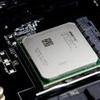AMD 990FX Chipset
The AMD 990FX Chipset
We have no doubt that if you go with an FX processor you'll also go for an 990FX chipset. So to understand the 990FX chipset from AMD, aimed at the more enthusiast PC user, all we simply need to do is tell you a thing or two about its features. The chipset consists of two chips that are added onto the motherboard PCB. The Northbridge chip, which is called the 990FX and the paired (Southbridge chip) SB950. Together they form the infrastructure for all standard devices, connectivity and interconnect bandwidth. The Northbridge chip primarily functions as a control HUB for your processor, memory and PCIe links towards your graphics chipset. It is the primary chip responsible for these functions, the FX (opposed to GX) extension however indicates that there is no IGP embedded into this ASIC which the GX versions do have.
The 990FX has many PCIe links available for your dedicated graphics (or other add-in cards). The chipset allows you to utilize two full x16 graphics cards, or even four graphics cards as they would run at x8 PCIe links. In theory these would be your possible PCIe lane configurations: 2x16 or 4x8 PCIe x16 and 6x1,1x4.

Now, there's more than the 990FX chipset as AMD will also launch a 970 and 990X chipset which will primarily get less available PCIe lanes. As stated, this chipset also includes native support for SATA 6Gb/s for aggressive RAID and SSD configurations and all motherboards now have USB 3.0 support thanks to a discrete USB 3.0 solution, but it's not embedded into the chipset. The 890 FX chipset already had it and 990FX will also get IOMMU support. Not something that the majority of you guys would be interested in but it allows for virtual addressing of memory by system devices. This enables devices to use their native drivers in a virtualized environment for enhanced performance. In a non-virtualized environment, IOMMU provides memory isolation and protection capabilities - device access to system memory is vetted by the IOMMU such that critical/unrelated memory information (e.g. kernel pages, protected content) can be protected, leading overall to a more robust system. With an updated Hyperlink revision 3.1 data path we can now connect to the SB950 chip which mainly handles system IO.
The SB950 Southbridge
The SB950 Southbridge is a merely a small update over the older SB7x0 and SB8x0 series. The Southbridge ASIC is always used for peripheral connectivity like your HDDs, audio, USB, PATA and so on. We see support for up-to six SATA 6G (SATA3) devices; 6G SATA connectors will increase the bandwidth on the SATA controller from 3 to 6 GBit/sec. Now for regular HDDs that is not really very important. But with the tremendous rise of fast SSD drives this really is a large plus.
Typically we get 3000 Mbit/s : 8 = 375 MB/sec bandwidth minus tolerances and random occurrences. SATA3 is doubling it up, as such we get 6000 Mbit/sec : 8 = 750 MB/sec of available bandwidth for your storage devices. As you can understand, with SSDs getting faster and faster that's just a much wanted and welcomed increase of bandwidth. You do need a SATA 6G HDD/SSD to be able to take advantage of that extra bandwidth of course. RAID performance can see massive benefits of the updated SATA interface. For SB950, RAID modes 0,1,5 and 10 are supported.
SB950 will allow you to connect up-to 14 USB 2.0 devices, comes with support for SATA3 and 8 channel HD Audio, the old fashioned PCI interface, and also included is native 1000/100/10 Mbit/s Ethernet. So what has changed in the chipset over 890 FX you might ask? Well, pretty frickin little to be honest, we did spot 4 PCIe links. The main chipset has new processor and socket support, RAID functionality has improved a bit and the PCIe data-paths and USB 3.0 paths have been optimized. Nothing new here really.


